Jacob Holmblad c.1830
An amazing difference can be seen between the early and the later Jacob Holmblad packs, covering a time span of only 17 years.
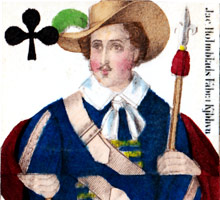
An amazing difference can be seen between the early and the later Jacob Holmblad packs, covering a time span of only 17 years. The earlier production was by stencil-coloured woodcut prints, but in around 1830 he adopted the newer techniques of lithography. Over the years Jacob Holmblad developed considerable workmanship and his playing cards became a success: already in 1823 he was advertising playing cards in ‘extra fine’ and ‘fine’ qualities. His advertisements also included Animal Tarots →

Above: double-ended playing cards by Jacob Holmblad, later period, c.1830. The red over-stamp on the A♥ refers to Jacob Holmblad's royal licence to print playing-cards which had been granted in 1820. The Danish playing-card tax stamp has three lions and a crown. The J♣ has the manufacturer's name.
After Jacob Holmblad's death in 1837, playing-card production was continued by his son Lauritz Peter Holmblad (1815-1890) see more →
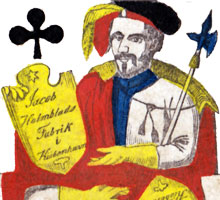
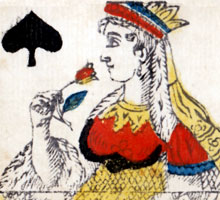
REFERENCES
Hinrup, Hans J.: The Holmblad Playing Card Patterns, in "The Playing-Card" vol.33 no.4, IPCS London, Apr-June 2005.
Jensen, K. Frank: French suited tarot packs in Denmark and the Jacob Holmblad Animal tarot, in "The Playing-Card" vol.36 no.3, IPCS London, Apr-June 2008. [download here].
All images courtesy K. Frank Jensen.
See earlier Jacob Holmblad decks →
By Simon Wintle
Spain • Member since February 01, 1996 • Contact
I am the founder of The World of Playing Cards (est. 1996), a website dedicated to the history, artistry and cultural significance of playing cards and tarot. Over the years I have researched various areas of the subject, acquired and traded collections and contributed as a committee member of the IPCS and graphics editor of The Playing-Card journal. Having lived in Chile, England, Wales, and now Spain, these experiences have shaped my work and passion for playing cards. Amongst my achievements is producing a limited-edition replica of a 17th-century English pack using woodblocks and stencils—a labour of love. Today, the World of Playing Cards is a global collaborative project, with my son Adam serving as the technical driving force behind its development. His innovative efforts have helped shape the site into the thriving hub it is today. You are warmly invited to become a contributor and share your enthusiasm.

Related Articles

Warburg’s Danske
Warburg’s Danske playing cards published by Aktieselskabet Emil Jensen, København, 1944.
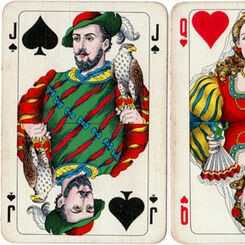
Standard Handa Pattern
Standard Danish playing cards made by Handa, Copenhagen.

Vasa Dynasty
The House of Vasa was the royal house of Sweden 1523–1654 and subsequent rulers have emphasized thei...

P. Steinmann
Single-figure provincial Paris pattern cards with traditional names on the courts manufactured in Co...
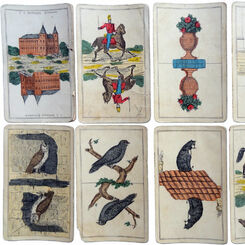
Gnav
cards from an early 'Gnav' game made by C.L.Keiblinger, Copenhagen c.1860
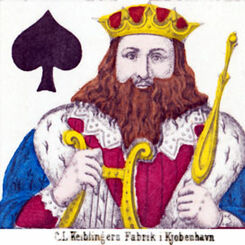
C.L.Keiblinger, Copenhagen 1852-85
C.L.Keiblinger, Copenhagen 1852-85
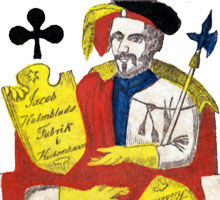
Jacob Holmblad, 1820s
The Q♥ has a butterfly net in which she has caught four hearts. Many of Holmblad's designs were repl...
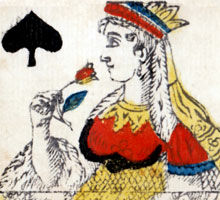
Jacob Holmblad c.1820
Standard woodblock and stencil deck produced by Jacob Holmblad with double-ended court cards in the ...
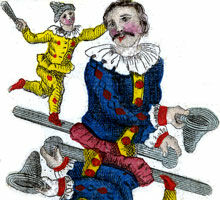
Holmblad Animal Tarot
Instead of the old emblematic designs, the trump cards show illustrations of animals, which could po...
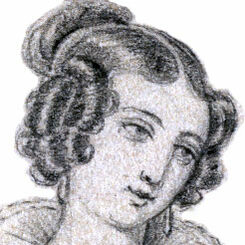
L. P. Holmblad, c.1845
Holmblad ordered his earlier designs to be re-drawn and updated. Comparison of packs from this era s...

Christian IV Anniversary
King Christian IV anniversary pack, designed by Thora Fisker and printed by L. Jevison Junior, 1988....

L. P. Holmblad c.1840
L. P. Holmblad's house pattern used from c.1840. The K♠ carries a harp as in the traditional French-...

Holmblads No. 121
Holmblads No. 121 made by John Waddington, England, for Denmark
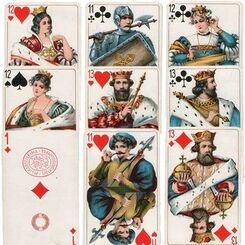
Playing cards from Finland
Playing cards from Finland. Finnish cards have a relatively short history, presumably because the co...
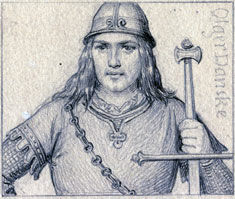
L. P. Holmblad - Denmark
Cards from c.1850 by L. P. Holmblad showing fantasy historical Danish Kings and Queens.
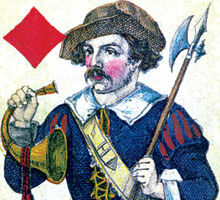
Danish Tarok Cards - Holmblad, c.1850
The traditional animal images on tarok decks are here substituted by images of buildings from Copenh...
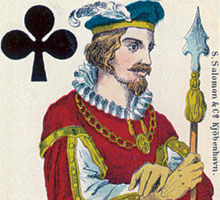
Danish Tarok Cards - Salomon & Co., c.1906
Danish Tarok cards published by S. Salomon & Co., Kjøbenhavn, c.1906.

Danish playing cards - Tarock trumps
Two versions of trump no.15 depicting the Thorvaldsen Museum.

Animal Tarok by Jean Friedrich Mayer (1752-1783)
Animal Tarok by Jean Friedrich Mayer (1752-1783).
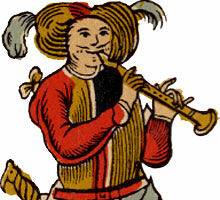
History of Danish Playing Cards
The earliest mention of playing-cards in Denmark dates from 1487 when King Hans, who reigned from 14...
Most Popular
Our top articles from the past 60 days






















